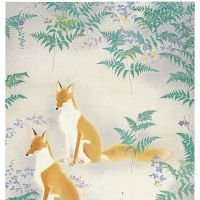Shoko Uemura (1902-2001) is a renowned nihonga (Japanese-style painting) artist, who is also known for being a son of the famous bijin-ga (paintings of beautiful women) artist Shoen Uemura (1875-1949) and the father of contemporary nihonga painter Atsushi Uemura.
Until the age of 27, Shoko painted mostly kachō-ga (pictures of birds and flowers). When he started teaching a class studying dōbutsu-ga (pictures of animals) at Kyoto Prefectural School of Painting (today's Kyoto City University of Arts), he also started drawing animals. Though he would visit the zoo to sketch with his students, he initially wasn't sure how animals would work with his style.
It wasn't until he was looking through an art book and found a picture of a prehistoric cave painting of a deer that he began to understand how to feature animals in his own work. The painting, which is in Spain's famous Cave of Altamira, made him appreciate wildlife, and he realized that he wanted to focus on depicting animal energy, not just their physical appearance. After that, Shoko drew many works using dynamic animal motifs. On display are around 30 paintings with some 10 sketches; till Jan. 29.
Shohaku Art Museum; (0742) 41-6666; 2-1-4 Tomigaoka, Nara; 5-min. bus ride from Gakuenmae Station, Kintetsu Nara Line. 10 a.m.-5 p.m. ¥800. Closed Mon., Dec. 26-Jan. 6, 10; open Jan. 9. www.kintetsu.jp/shohaku.

















With your current subscription plan you can comment on stories. However, before writing your first comment, please create a display name in the Profile section of your subscriber account page.